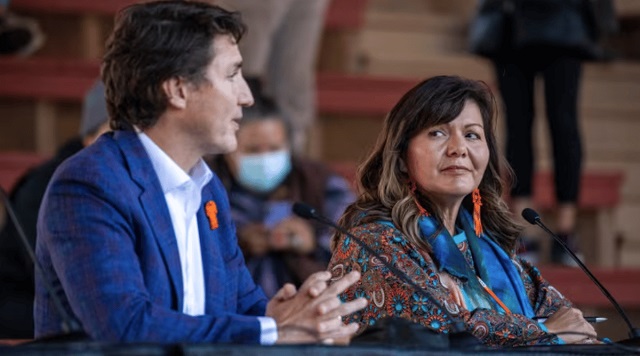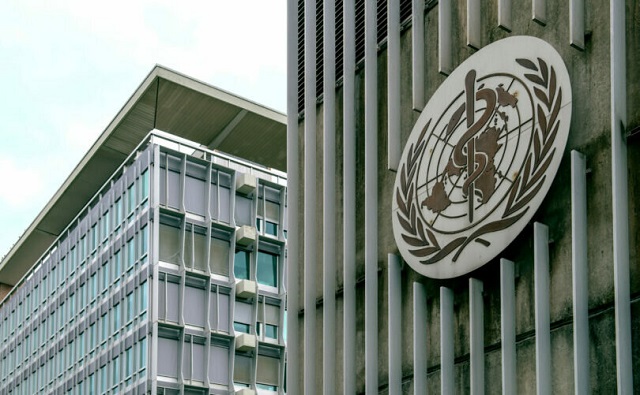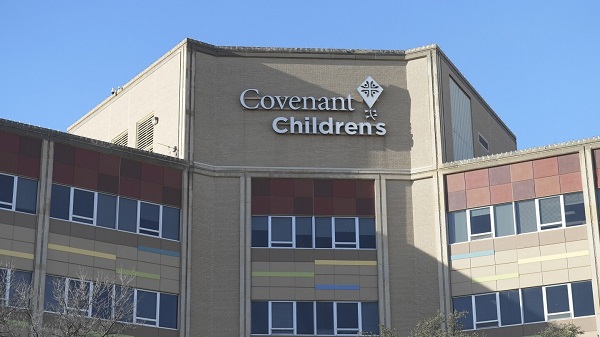Frontier Centre for Public Policy
Why is Trudeau sticking to the unmarked graves falsehood?

From the Frontier Centre for Public Policy
There is simply no possibility that Trudeau didn’t know on June 17th, 2024 that he was spreading misinformation when he said that unmarked graves were found. In plain English — he knew he was lying.
The claim made by Chief Rosanne Casimir on May 27th, 2021, that the remains of 215 children, former students of the Kamloops Indian Residential School (KIRS) had been found in unmarked graves on the school grounds, was false.
Only soil anomalies were detected by a radar device. Those anomalies could be tree roots, previous excavations, or almost anything. In fact, research since that time makes it clear that the anomalies were almost certainly the trenches of a former septic field installed in 1924 to dispose of the school’s sewage.
No “unmarked graves”, “human remains”, “bodies” or “mass graves” were found.
Chief Casimir finally confessed to making that false claim three years after making it. She admitted what was known to most of all along: no graves, human remains, or bodies were found — only 215 “anomalies”.
So, everyone in Canada now knows that the May 27th, 2021 claim of unmarked graves containing human remains found at Kamloops was false. Everybody except the prime minister it seems, and his former Indigenous Affairs Minister, Marc Miller.
However on June 17th, 2024, Prime Minister Trudeau — instead of taking the opportunity to set the record straight — repeated at an indigenous event the whopper that “unmarked graves” have been found. He has been spreading that misinformation for three years.
One would think that now that the person who originally made the false claim has admitted that no graves were found — only anomalies — that Trudeau would take the opportunity to clear up the confusion and go with the truth, instead of repeating the original lie.
There is simply no possibility that Trudeau didn’t know on June 17th, 2024 that he was spreading misinformation when he said that unmarked graves were found. In plain English — he knew he was lying.
So, why would he do such a thing? Doesn’t a prime minister have a duty to refrain from deliberately lying to Canadian citizens? After all, the great majority of Canadians know by now that no graves were found at Kamloops.
The only answer that makes sense is that the Prime Minister was not speaking to all Canadians on June 17th, 2024. He was speaking only to indigenous Canadians when he falsely stated that unmarked graves had been found at Kamloops. He was repeating a lie they believed. They believed that lie in large part because he and Marc Miller were doing their best to keep the lie alive.
Everything that he and his colleagues have done since May 27, 2021 — lowering flags, kneeling with a teddy bear in an ordinary community cemetery, lavishing money on indigenous communities to search for missing children he knows were never “missing” — has been done to pander to an indigenous community that largely believes those false stories about evil priests and secret burials. I repeat — believes that anti- Catholic bilge in large part because the Trudeau Liberals have encouraged them to believe it.
What has come to be known as the “Kamloops Graves Hoax” is now known to most Canadians for what it is — a false claim. However, we have a prime minister who, for his own reasons, seems intent on keeping the hoax going within the indigenous community. The deception being practiced by the prime minister will have serious consequences in the years ahead. And those consequences are all negative.
Prime ministers come and go. Some remain popular throughout their term, but some become increasingly unpopular. For example, the late Brian Mulroney was so unpopular with Canadians toward the end of his term that the Conservatives, led by his successor, Kim Campbell, were virtually wiped in the election following his retirement.
Trudeau’s fate remains to be seen.
However, that is just politics. But what Trudeau is doing, in deliberately lying to an already marginalized demographic that has a history of being lied to by indigenous and non-indigenous politicians, is not just politics. It is reprehensible conduct. Those people are going to be very angry when they realize that they have been deceived.
Under Trudeau’s watch, we have already seen churches burn, statues topple, and other mayhem as a result of a claim that the PMO knows is false.
Exactly why he is practicing this deception we do not know. We do know with certainty that Indigenous Affairs Minister Marc Miller spoke with Chief Rosanne Casimir on the evening of May 27, 2021, immediately after she made her false claim that the remains of 215 children, who were students at KIRS, had been found. Here’s what he said about his May 27, 2021 telephone conversation with Casimir, according to Hansard:
“On Thursday evening, I spoke to Chief Casimir and assured her of my steadfast support for the grieving and reconciliation process over the coming weeks. We have been in contact since then as well. We will be there with them as they lead this initiative, and we will help meet their needs in the coming weeks and months.”
Unless Chief Casimir told Miller that “remains” had been found, and not the truth — that only anomalies had been detected — the Trudeau government and the Kamloops band together, for reasons unknown, created the false narrative that the remains of 215 children had been found, knowing that their claim was false. Why did this happen?
The prime minister is now keeping this false narrative alive, knowing that it was, and is, false. Why is he doing this?.
And why are the CBC and our mainstream media not even trying to find out?
Something is very wrong here.
Brian Giesbrecht, retired judge, is a Senior Fellow at the Frontier Centre for Public Policy
Education
Our Kids Are Struggling To Read. Phonics Is The Easy Fix

From the Frontier Centre for Public Policy
One Manitoba school division is proving phonics works
If students don’t learn how to read in school, not much else that happens there is going to matter.
This might be a harsh way of putting it, but it’s the truth. Being unable to read makes it nearly impossible to function in society. Reading is foundational to everything, even mathematics.
That’s why Canadians across the country should be paying attention to what’s happening in Manitoba’s Evergreen School Division. Located in the Interlake region, including communities like Gimli, Arborg and Winnipeg Beach, Evergreen has completely overhauled its approach to reading instruction—and the early results are promising.
Instead of continuing with costly and ineffective methods like Reading Recovery and balanced literacy, Evergreen has adopted a structured literacy approach, putting phonics back at the centre of reading instruction.
Direct and explicit phonics instruction teaches students how to sound out the letters in words. Rather than guessing words from pictures or context, children are taught to decode the language itself. It’s simple, evidence-based, and long overdue.
In just one year, Evergreen schools saw measurable gains. A research firm evaluating the program found that five per cent more kindergarten to Grade 6 students were reading at grade level than the previous year. For a single year of change, that’s a significant improvement.
This should not be surprising. The science behind phonics instruction has been clear for decades. In the 1960s, Dr. Jeanne Chall, director of the Harvard Reading Laboratory, conducted extensive research into reading methods and concluded that systematic phonics instruction produces the strongest results.
Today, this evidence-based method is often referred to as the “science of reading” because the evidence overwhelmingly supports its effectiveness. While debates continue in many areas of education, this one is largely settled. Students need to be explicitly taught how to read using phonics—and the earlier, the better.
Yet Evergreen stands nearly alone. Manitoba’s Department of Education does not mandate phonics in its public schools. In fact, it largely avoids taking a stance on the issue at all. This silence is a disservice to students—and it’s a missed opportunity for genuine reform.
At the recent Manitoba School Boards Association convention, Evergreen trustees succeeded in passing an emergency motion calling on the association to lobby education faculties to ensure that new teachers are trained in systematic phonics instruction. It’s a critical first step—and one that should be replicated in every province.
It’s a travesty that the most effective reading method isn’t even taught in many teacher education programs. If new teachers aren’t trained in phonics, they’ll struggle to teach their students how to read—and the cycle of failure will continue.
Imagine what could happen if every province implemented structured literacy from the start of Grade 1. Students would become strong readers earlier, be better equipped for all other subjects, and experience greater success throughout school. Early literacy is a foundation for lifelong learning.
Evergreen School Division deserves credit for following the evidence and prioritizing real results over educational trends. But it shouldn’t be alone in this.
If provinces across Canada want to raise literacy rates and give every child a fair shot at academic success, they need to follow Evergreen’s lead—and they need to do it now.
All students deserve to learn how to read.
Michael Zwaagstra is a public high school teacher and a senior fellow at the Frontier Centre for Public Policy.
Economy
Support For National Pipelines And LNG Projects Gain Momentum, Even In Quebec

From the Frontier Centre for Public Policy
Public opinion on pipelines has shifted. Will Ottawa seize the moment for energy security or let politics stall progress?
The ongoing threats posed by U.S. tariffs on the Canadian economy have caused many Canadians to reconsider the need for national oil pipelines and other major resource projects.
The United States is Canada’s most significant trading partner, and the two countries have enjoyed over a century of peaceful commerce and good relations. However, the onset of tariffs and increasingly hostile rhetoric has made Canadians realize they should not be taking these good relations for granted.
Traditional opposition to energy development has given way to a renewed focus on energy security and domestic self-reliance. Over the last decade, Canadian energy producers have sought to build pipelines to move oil from landlocked Alberta to tidewater, aiming to reduce reliance on U.S. markets and expand exports internationally. Canada’s dependence on the U.S. for energy exports has long affected the prices it can obtain.
One province where this shift is becoming evident is Quebec. Historically, Quebec politicians and environmental interests have vehemently opposed oil and gas development. With an abundance of hydroelectric power, imported oil and gas, and little fossil fuel production, the province has had fewer economic incentives to support the industry.
However, recent polling suggests attitudes are changing. A SOM-La Presse poll from late February found that about 60 per cent of Quebec residents support reviving the Energy East pipeline project, while 61 per cent favour restarting the GNL Quebec natural gas pipeline project, a proposed LNG facility near Saguenay that would export liquefied natural gas to global markets. While support for these projects remains stronger in other parts of the country, this represents a substantial shift in Quebec.
Yet, despite this change, Quebec politicians at both the provincial and federal levels remain out of step with public opinion. The Montreal Economic Institute, a non-partisan think tank, has documented this disconnect for years. There are two key reasons for it: Quebec politicians tend to reflect the perspectives of a Montreal-based Laurentian elite rather than broader provincial sentiment, and entrenched interests such as Hydro-Québec benefit from limiting competition under the guise of environmental concerns.
Not only have Quebec politicians misrepresented public opinion, but they have also claimed to speak for the entire province on energy issues. Premier François Legault and Bloc Québécois Leader Yves-François Blanchet have argued that pipeline projects lack “social licence” from Quebecers.
However, the reality is that the federal government does not need any special license to build oil and gas infrastructure that crosses provincial borders. Under the Constitution, only the federal Parliament has jurisdiction over national pipeline and energy projects.
Despite this authority, no federal government has been willing to impose such a project on a province. Quebec’s history of resisting federal intervention makes this a politically delicate issue. There is also a broader electoral consideration: while it is possible to form a federal government without winning Quebec, its many seats make it a crucial battleground. In a bilingual country, a government that claims to speak for all Canadians benefits from having a presence in Quebec.
Ottawa could impose a national pipeline, but it doesn’t have to. New polling data from Quebec and across Canada suggest Canadians increasingly support projects that enhance energy security and reduce reliance on the United States. The federal government needs to stop speaking only to politicians—especially in Quebec—and take its case directly to the people.
With a federal election on the horizon, politicians of all parties should put national pipelines and natural gas projects on the ballot.
Joseph Quesnel is a senior research fellow with the Frontier Centre for Public Policy.
-

 2025 Federal Election2 days ago
2025 Federal Election2 days agoRCMP Whistleblowers Accuse Members of Mark Carney’s Inner Circle of Security Breaches and Surveillance
-

 Also Interesting2 days ago
Also Interesting2 days agoBetFury Review: Is It the Best Crypto Casino?
-

 Autism2 days ago
Autism2 days agoRFK Jr. Exposes a Chilling New Autism Reality
-

 COVID-191 day ago
COVID-191 day agoCanadian student denied religious exemption for COVID jab takes tech school to court
-

 2025 Federal Election2 days ago
2025 Federal Election2 days agoBureau Exclusive: Chinese Election Interference Network Tied to Senate Breach Investigation
-

 International2 days ago
International2 days agoUK Supreme Court rules ‘woman’ means biological female
-

 2025 Federal Election1 day ago
2025 Federal Election1 day agoNeil Young + Carney / Freedom Bros
-

 Health1 day ago
Health1 day agoWHO member states agree on draft of ‘pandemic treaty’ that could be adopted in May





